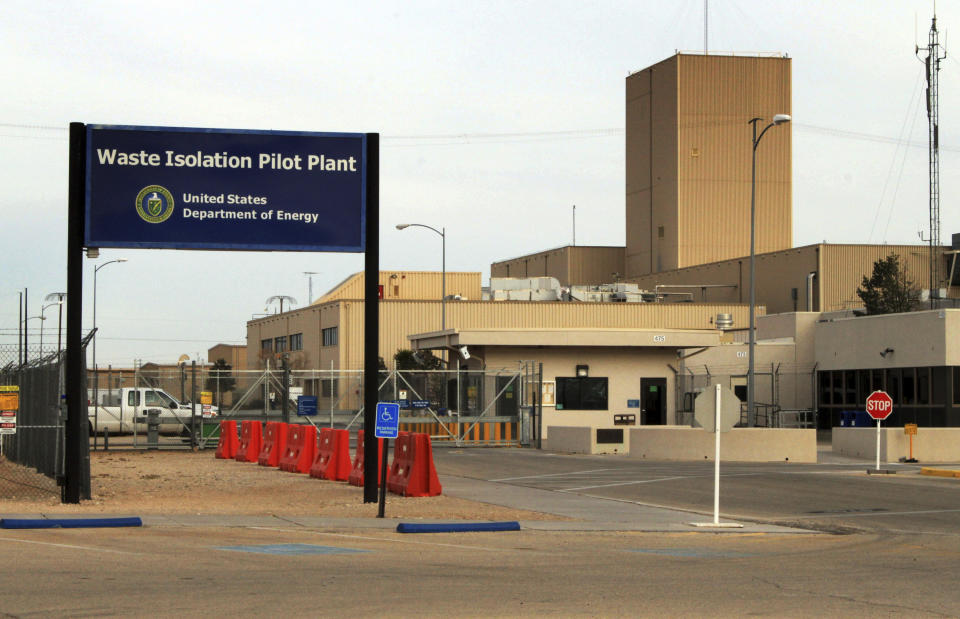New Mexico regulators worry about US plans to ship radioactive waste back from Texas

ALBUQUERQUE, N.M. (AP) — Federal officials gathered Tuesday in southern New Mexico to mark the 25th anniversary of the nation’s only underground repository for radioactive waste resulting from decades of nuclear research and bomb making.
Carved out of an ancient salt formation about half a mile (800 meters) deep, the Waste Isolation Pilot Plant outside Carlsbad has taken in around 13,850 shipments from more than a dozen national laboratories and other sites since 1999.
The anniversary comes as New Mexico raises concerns about the federal government’s plans for repackaging and shipping to WIPP a collection of drums filled with the same kind of materials that prompted a radiation release at the repository in 2014.
That mishap contaminated parts of the underground facility and forced an expensive, nearly three-year closure. It also delayed the federal government’s multibillion-dollar cleanup program and prompted policy changes at labs and other sites across the U.S.
Meanwhile, dozens of boxes containing drums of nuclear waste that were packed at the Los Alamos National Laboratory to be stored at WIPP were rerouted to Texas, where they've remained ever since at an above-ground holding site.
After years of pressure from Texas environmental regulators, the U.S. Department of Energy announced last year that it would begin looking at ways to treat the waste so it could be safely transported and disposed of at WIPP.
But the New Mexico Environment Department is demanding more safety information, raising numerous concerns in letters to federal officials and the contractor that operates the New Mexico repository.
“Parking it in the desert of West Texas for 10 years and shipping it back does not constitute treatment,” New Mexico Environment Secretary James Kenney told The Associated Press in an interview. “So that’s my most substantive issue — that time does not treat hazardous waste. Treatment treats hazardous waste.”
The 2014 radiation release was caused by improper packaging of waste at Los Alamos. Investigators determined that a runaway chemical reaction inside one drum resulted from the mixing of nitrate salts with organic kitty litter that was meant to keep the interior of the drum dry.
Kenney said there was an understanding following the breach that drums containing the same materials had the potential to react. He questioned how that risk could have changed since the character and composition of the waste remains the same.
Scientists at Sandia National Laboratories in Albuquerque were contracted by the DOE to study the issue. They published a report in November stating that the federal government's plan to repackage the waste with an insulating layer of air-filled glass micro-bubbles would offer “additional thermal protection."
The study also noted that ongoing monitoring suggests that the temperature of the drums is decreasing, indicating that the waste is becoming more stable.
DOE officials did not immediately answer questions about whether other methods were considered for changing the composition of the waste, or what guarantees the agency might offer for ensuring another thermal reaction doesn't happen inside one of the drums.
The timetable for moving the waste also wasn't immediately clear, as the plan would need approval from state and federal regulators.
Kenney said some of the state's concerns could have been addressed had the federal government consulted with New Mexico regulators before announcing its plans. The state in its letters pointed to requirements under the repository's permit and federal laws for handling radioactive and hazardous wastes.
Don Hancock, with the Albuquerque-based watchdog group Southwest Research and Information Center, said shipments of the untreated waste also might not comply with the Nuclear Regulatory Commission's certification for the containers that are used.
“This is a classic case of waste arriving somewhere and then being stranded — 10 years in the case of this waste,” Hancock said. “That’s a lesson for Texas, New Mexico, and any other state to be sure that waste is safe to ship before it’s allowed to be shipped.”
